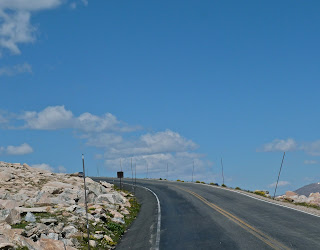If God were to somehow decree
that you could have but one hike in California’s Sierra
…and you had to complete it in less than a day...
this might be that hike.
My hiking buddy, brother Tim, had an
appendix removed a week earlier, so, we figured, it was high time to overdo it. Our common hike up around Duncan’s Peak
(Placer County, Tahoe National Forest) seemed appropriate, but we’d done that a
month back.
Tim had read about a little loop out of Woods Lake (Carson
Pass area, Alpine County, El Dorado National Forest.) I’d been there, wasn’t recovering from surgery, and figured
I could keep up with him, so I said, “Sure.”
I’d stumbled across Woods Lake
thirty years ago when looking simply for a place to stretch out after evening
had fallen. Awakening to this marvelous alpine lake set among firs at the base
of granitic outcrops prompted me to wonder whether I’d wandered into heaven.
Return visits have found me exploring – and later showing
off – the four-plus mile trail that loops past Round Top and Winnemucca
Lakes. Sometimes I’ll ride the
bike to the trailhead, but sometimes I’ll feel like bringing along the
dog.
I point out a sign to Edward, the lab mix, who returns a
look that says, You know I can’t read, ya
idjit. Can’t we just go?
The old trail used to run past the Lost Cabin Mine, then a
working claim, amply labeled with keep out signs. Whatever happened to that route escapes me; the only sign of
the district’s mining heritage is a derelict Model A chassis, long ago converted
with a pulley to accommodate a belt, which provided power down a now-iron-gated
shaft.
The trail ventures south and west
out of the campground – at least in the direction we elected. The path is well used, therefore requiring
little grooming. Steep, with
rollie-pollie golf-ball sized rocks in some stretches, Tim breaks out his
hiking poles. I should have done
so as well.
Harsh winters and summer foot traffic combine to expose
roots on the route. The stand of
pines attached to these tendrils, thrive, but the footing can be delicate.
In late June, I remember this route slicing through glades
and meadows of clown lupine and mules ears. This time, in early August of a dry year, the plant life
looks to be more thick-leaved and succulent. The precursors, festive and alive a month before are but dry
stalks turning to dust.
Summiting a small ridge, we find Round Top Lake, an emerald
pond at the base of its namesake mountain. On her western flank, we can see hikers who’d gotten a much
earlier start already descending.
We would forego this spur this day.
Glaciers work in slow and
predictable ways pushing ridges of gravel and sand ahead of them as they creep
down the mountain and leaving those ridges – or moraines – behind when they
retreat. Plants adapt to short dry
summers in nutrient-weak soils.
Advancing and retreating over eons, pools form behind the
moraines called Paternoster Lakes.
The Sierra is full of them.
Of varying depths and sizes, their water temperature varies as well –
each supporting a slightly different cast of living things.
We trek across one of those ancient ice-age remnants on our
route to Winnemucca Lake. At
elevation, stunted pines and the occasional juniper are targets for lightning.
Cresting the moraine, Winnemucca Lake reflects the topaz
blue of a high Sierran sky. Big
enough for a nice swim, but even in August, my fingertip assessment of water temperature invites me to
stay ashore. And Tim still had
stitches.
A trail forks from Winnemucca over
to Carson Pass, about 2 miles further east. Hikers there on must have that top-o-the-world feeling that comes with
tickling the sky’s belly.
But our intended loop gives up elevation quickly as we
descend a drainage back down to Woods Lake. I break out my hiking poles for this section and, although I
feel like a human version of a daddy long leg spider, I wish I’d used them on
the way up the hill and will, in the future.
Edward and his buddy, Bernie, enjoy a last moment of hydration
before hopping in the Prius (it gets better gas mileage than either of my motorcycles and it runs on regular) for a two-hour ride home.
o0o
Today’s Route: CA 88 east from Jackson or west from
Hope Valley over Carson Pass, or US 50 to Pollack Pines, east on the Mormon
Emigrant Trail to CA 88, east on 88. South on Woods Lake Road 1.5 miles to
trail head, two miles to Woods Lake.
Fee.
© 2013

























































